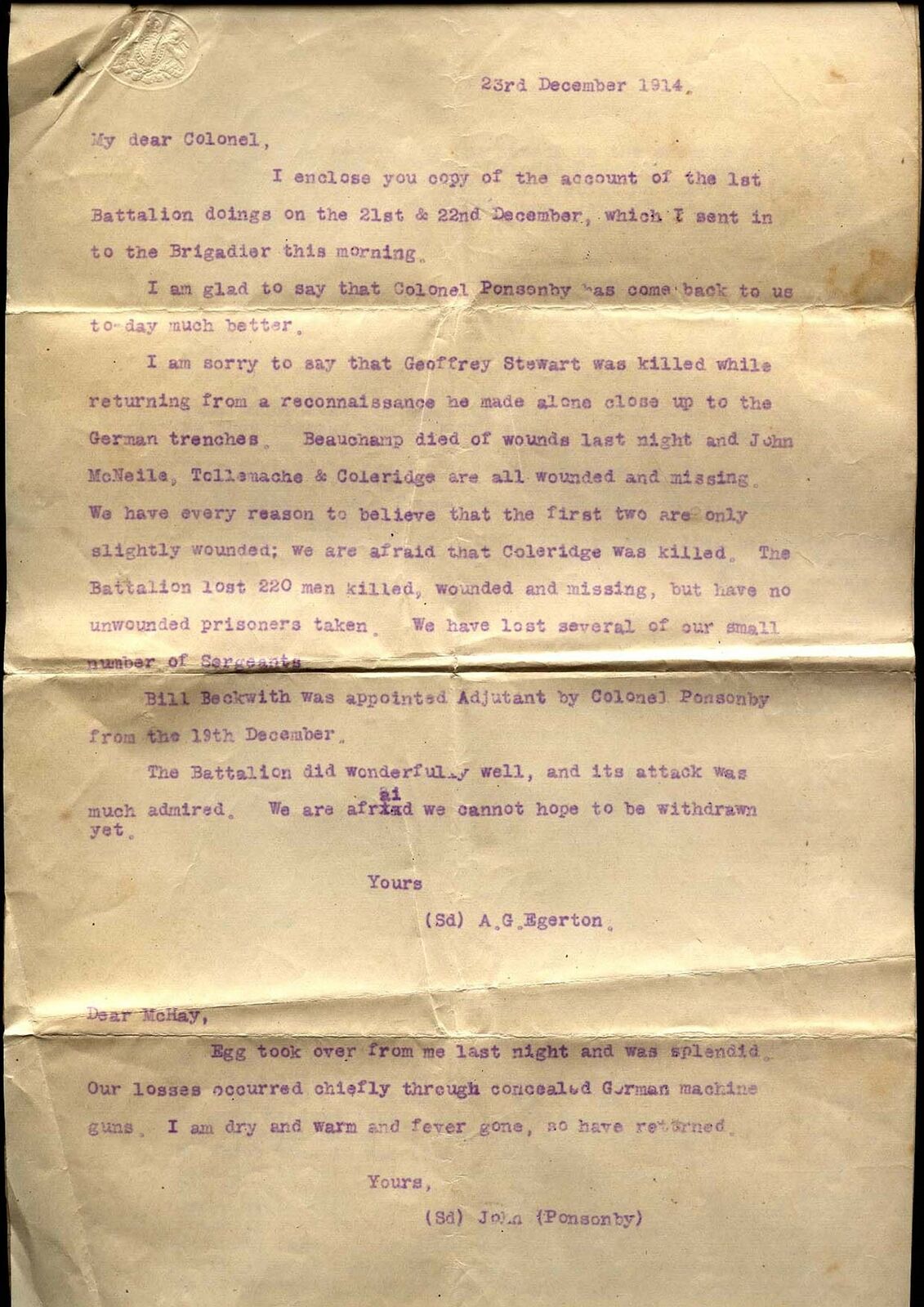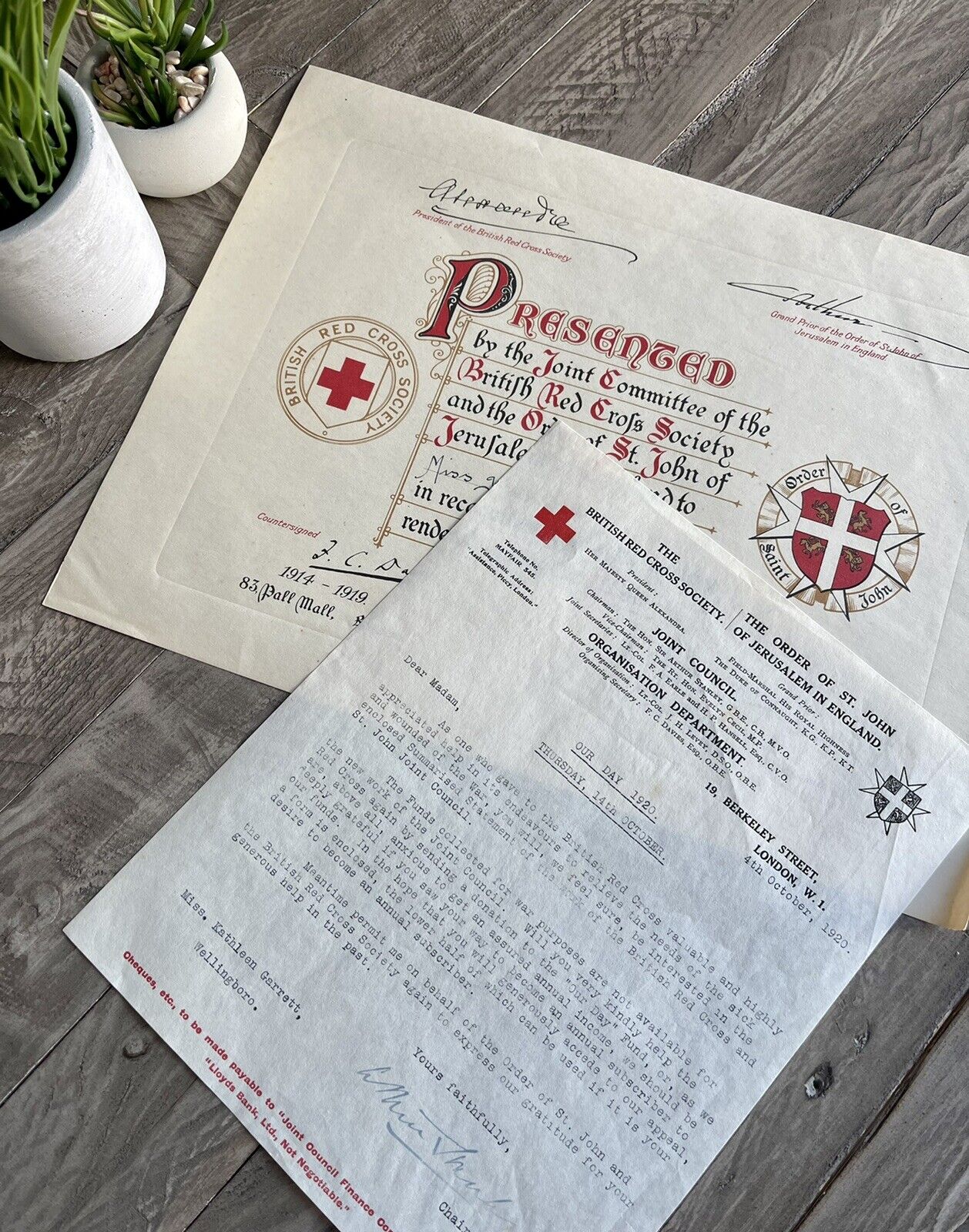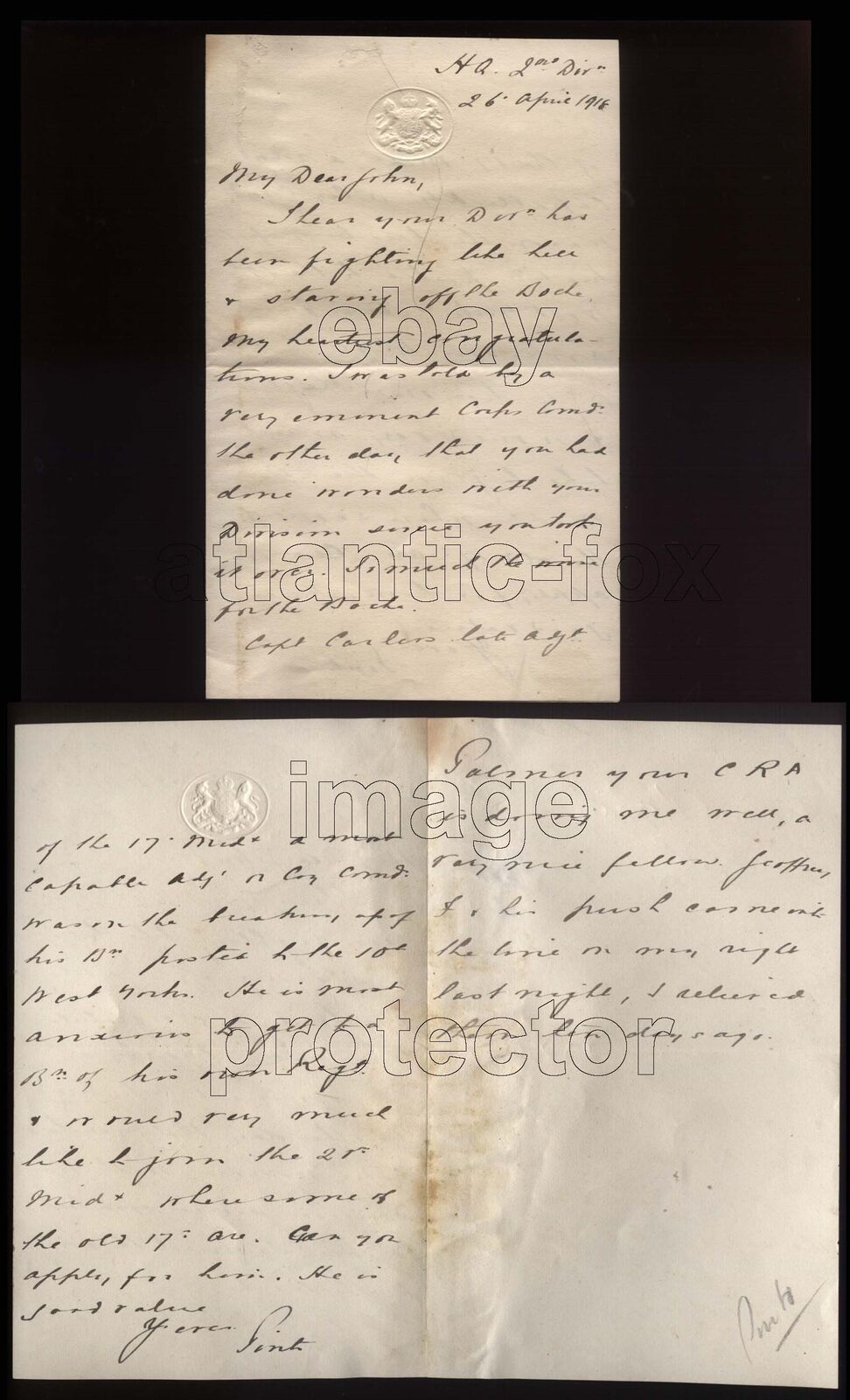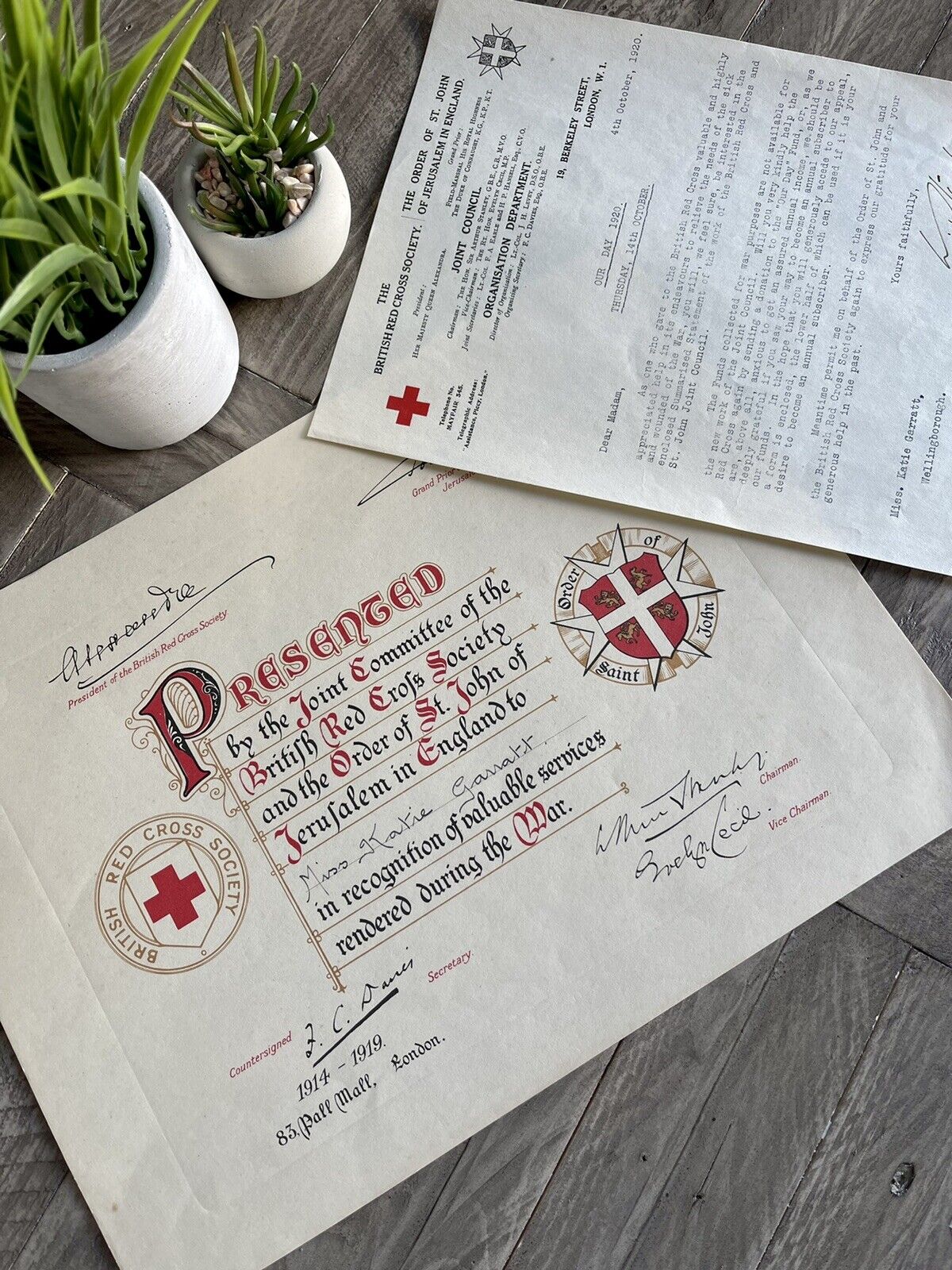-40%
RARE 1914 BATTLE OF GIVENCHY Lieut. Col John Ponsonby his original battle REPORT
$ 396.67
- Description
- Size Guide
Description
RARE 1914 BATTLE OF GIVENCHY Lieut. Col John Ponsonby his original battle REPORTThis product data sheet is originally written in English.
VERY RARE - 1914 BATTLE OF GIVENCHY. Lieut. Col John Ponsonby his own personal original copy of the BATTLE REPORT dated 23rd December Signed A.G.Egerton to Colonel Ponsonby and Ponsonbys letter to McHay, with Two attached detailed pages of the attack on the German positions 21st & 22nd December. being in purple ink carbon typed copy on official Crown Crested paper. 3 pages.
Fresh to the Market Place, from Major-General Sir John Ponsonby's Collection
For more from this collection see our shop category for SIR JOHN PONSONBY COLLECTION
John Ponsonby (British Army officer)From Wikipedia, the free encyclopedia
Major-General Sir John Ponsonby KCB CMG DSO (25 March 1866 – 26 March 1952) was a British Army officer who commanded 5th Division during World War I
Born the son of Sir Henry Ponsonby (Queen Victoria's Private Secretary), his Mother Hon. Mary Elizabeth Ponsonby, Maid of Honour to Queen Victoria and a daughter of John Crocker Bulteel.
His brothers were Frederick Ponsonby, ( Assistant Private Secretary to Edward VII & GV), and Arthur Augustus William Harry Ponsonby, 1st Baron Ponsonby of Shulbrede, (British politician, writer, and social activist).
Sir John was educated at Eton College, He was gazetted to the Royal Irish Rifles 16 November 1887, and to the Coldstream Guards 15 August 1888, becoming Lieutenant 29 June 1891. He was ADC to the Governor and Commander-in-Chief, South Africa, 10 August 1891 to 30 January 1895; served in operations in Matabeleland (Medal); was promoted to Captain 7 September 1898, and in that year served in Uganda (Medal), and again in 1899, during the operations against Kabarega (clasp). Captain Ponsonby served in the South African War, 1899-1902, on special service with the Rhodesian Field Force, 19 February 1900 to 7 July 1901. He was Adjutant, 5th New Zealand Regiment, 8 June 1900 to 1 January 1901; afterwards in command 1 January to 18 January 1901. From February to May 1900, be was employed with Mounted Infantry, and he took part in operations in the Transvaal, west of Pretoria, from July to 29 November 1900; operations in the Transvaal, February to June 1901; operations in Cape Colony, February to 31 May 1902. He was mentioned in Despatches [London Gazette, 10 September 1901]; received the Queen's Medal with four clasps, the King's Medal with two clasps, and was created a Companion of the Distinguished Service Order [London Gazette, 27 September 1901]: "John Ponsonby, Captain, Coldstream Guards. In recognition of services during the operations in South Africa". The Insignia were presented by the King 27 October 1901. He was promoted to Major 23 January 1904, and commanded the Guards' Depot 1 March 1905 to 28 February 1907. He became Lieutenant Colonel 28 October 1913.
Lieutenant Colonel Ponsonby served in the European War, 1914—18;
Landed in France 13th August 1914 in charge of 1st Coldstream Guards,Wounded 15th September & returned to unit 21st November
. commanded the 2nd Guards Brigade, BEF, 26 August 1915 to 19 November 1916: was given the Brevet of Colonel 1 January 1916; commanded the Special Reserve Infantry Brigade 28 November 1916 to 7 March 1917; commanded the 21st Infantry Brigade, BEF, 8 March to 20 March 1917; became Colonel 20 March 1917; commanded the 2nd Guards Brigade, British Armies in France, 21 March to 21 August 1917; commanded the 40th Division, British Armies in France, 22 August 1917 to 3 July 1918; subsequently commanded the 5th Division, British Armies in France, 4 July 1918 to 1 April 1919; was promoted to Major General 1 January 1919. He was mentioned in Despatches; created a CMG in 1915, a CB in 1918, and was given the Brevet of Colonel.
He went on to become General Officer Commanding 5th Division remaining in that role until the end of the War. After the War he became General Officer Commanding the Madras District of India. He retired in 1928.
He lived at Haile Hall near Beckermet in Cumbria
BATTLE OF GIVENCHY
On the 16th October 1914 the 1st Battalion Coldstream Guards had left the area of the River Aisne as part of the 1st (Guards) Brigade, 1st Division , for Flanders. The other battalions in the Brigade were the 1st Scots Guards, 1st Black Watch (Royal Highlanders) and 1st Queen’s Own Cameron Highlanders (replacing the 2nd Battalion The Royal Munster Fusiliers, who had been destroyed whilst acting as the rearguard at Etreux (a small town some 10 miles South East of Le Cateau, Nord) holding off six German Battalions. The 1st Battalion reached Hazebrouck to participate in the First Battle of Ypres holding the line from 20th October to 20th November 1914 leaving Ypres, then in ruins, to march to Meteren, some 15 miles to the south, reduced to 3 officers and 122 other ranks moving on the 23rd November 5 miles to the West to Pradelles, by which time the 1/14th (County of London) Battalion of the London Regiment (the London Scottish) had joined the Brigade. From the 28th November to the 19th December 1914 the Battalion was billeted at Strazeele, reforming and training, being inspected by His majesty King George V on the 3rd December.
At this time the British line before La Bassee, one of the German strong points of the German front covering Lille, was held by the Indian Corps and on the 20th December 1914 The Germans attacked in great force mainly against the village of Givenchy which commanded all the country to the west. The village was captured although later in the day part to the south and east was recovered and the 1st (Guards) Brigade was ordered south at 5 p.m. on the 20th December marching some 20 miles to Bethune and then at 12 noon on the 21st the Brigade marched East on the Bethune/La Bassee road to the south of the La Bassee Canal, the Cameron Highlanders leading followed by the Coldstream Guards to Pont Fixe, Givenchy. Brigade orders were issued on route to attack Rue d’Ouvert from Pont Fixe, cooperating if possible with 3rd Infantry Brigade on the left. The Guards Brigade attacked at 3 p.m. with the Coldstream Guards and the Cameron Highlanders in the first line. A few shells caused one or two casualties in the village while crossing the Pont Fixe, with this exception the enemy’s artillery fire caused no damage. As soon as the attack started the leading companies came under enfilade rifle and machine gun fire but owing to a heavy hailstorm which came on right in the enemy’s face, casualties were not heavy. Three Companies occupied the old French trenches on the reverse slope of the spur about 300 yards West of the trenches evacuated by the Indian troops on the 19th December, now held by the Germans. Lieutenant Colonel John Ponsonby established his H.Q. in the end house of Givenchy Village with a Company in trenches nearby. A patrol under 2nd Lieutenant Mills went forward to the end of Givenchy village and reported it clear of the enemy so far as the Church. Attempts were made overnight to straighten up the line and get in touch with the Gloucesters on the left and the Cameron Highlanders on the right but proper touch could not be obtained. Lieutenant Colonel Ponsonby assisted by Captain Daniels 15th Sikhs made a reconnaissance and found a Company of the London Scottish on the left rear of No 2 Company of the Coldstream Guards which were almost immediately withdrawn. At 5.45 a.m. on the 22nd December the three companies in the forward trenches attacked the German trench along the road leading from Givenchy to Chapelle St. Roche and took it but being without any support on their flanks they were bombed out of it about 8 a.m. and retired to the North of the ruins of the church in Givenchy having lost over 50% of their strength. With the Scots Guards and the London Scottish holding the remaining parts of Givenchy so began the daily routine of siege warfare in this area of Givenchy.
At 9 p.m. on the 22nd December the Battalion was relieved by the Black Watch and marched back to billets in a village south of the canal at Pont Fixe, billets being farm buildings around a dirty midden, the weather being wet and cold. The following day the Battalion moved to Cambrin to Brigade Reserve returning to the Givenchy trenches on the 26th December until the 28th December when the Battalion moved to billets in Bethune.
On the 29th December 1914 a draft of 100 men was received and then on the 31st December the Battalion went back to Beuvry some 2 miles South East of Bethune and the following day to Annequin South of the canal to form with another battalion the Divisional Reserve. On the 2nd January 1915 the Battalion relieved the 1st Battalion the Northamptonshire Regiment in the trenches at Givenchy until relief on the 12th January. “3rd January -The trenches occupied by Nos. 1, 2 and 3 Companies are quite good and fairly dry; those of No 4 were very wet, liquid mud everywhere up to one’s knees. The Germans shelled the road all the afternoon. Poured with rain.” “ 7th January - Owing to the heavy rains the trenches are beginning to fall in in many places. Pouring with rain as usual; our cellar is full of water, and in order not be drowned the Battalion HQ are moved down the road near Pont Fixe.”
:
Powered by SixBit's eCommerce Solution
VERY RARE - 1914 BATTLE OF GIVENCHY. Lieut. Col John Ponsonby his own personal original copy of the BATTLE REPORT dated 23rd December Signed A.G.Egerton to Colonel Ponsonby and Ponsonbys letter to McHay, with Two attached detailed pages of the attack on the German positions 21st & 22nd December. being in purple ink carbon typed copy on official Crown Crested paper. 3 pages. Fresh to the Market Place, from Major-General Sir John Ponsonby's Collection For more from this collection see our shop category for SIR JOHN PONSONBY COLLECTION John Ponsonby (British Army officer)From Wikipedia, the free encyclopedia Major-General Sir John Ponsonby KCB CMG DSO (25 March 1866 – 26 March 1952) was a British Army officer who commanded 5th Division during World War I Born the son of Sir Henry Ponsonby (
Country/ Organization
Great Britain
Service
Army
EAN
Does Not apply
Type
Document
City/Town/Village
Givenchy
Theme
Military
Famous Persons in History
Major General Sir John Ponsonby
Year of Issue
1914
Country
France
Issued/ Not-Issued
Issued
Document type
Field Battle Report
Conflict
World War I (1914-1918)










